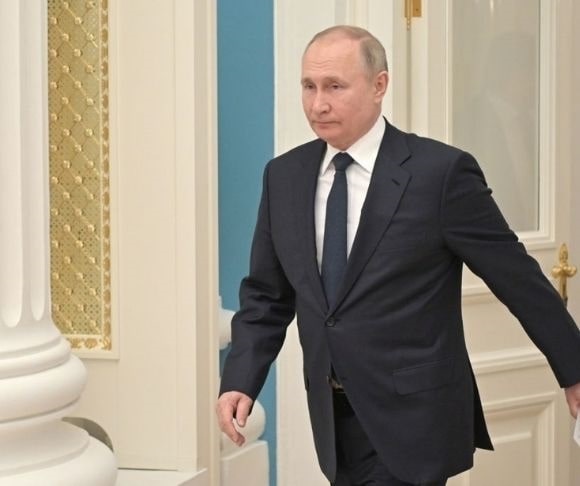Russian President Vladimir Putin has made good on his threat to invade Ukraine. “Make no mistake, Putin is about the business of trying to bring back the Soviet Union,” asserted Mike Pompeo, former secretary of state under the Trump administration, to Fox News. Nearly every public statement the Kremlin’s leader has made lends credence to Pompeo’s words. But Ukraine isn’t the only country that established its sovereignty following the dissolution of the Union of Soviet Socialist Republics (USSR). So, where will Russia strike next?
 To get a better perspective, Liberty Nation talked with James Farwell, author of The New York Times bestseller The Corporate Warrior and co-author of “Where and How Russia Will Strike Next,” a monograph sponsored by SMA, Inc. for the under secretary of defense for policy in 2020.* As Farwell explained in the report, the most likely targets of Moscow’s aggression are countries with large ethnic Russian populations. But is that still his position?
To get a better perspective, Liberty Nation talked with James Farwell, author of The New York Times bestseller The Corporate Warrior and co-author of “Where and How Russia Will Strike Next,” a monograph sponsored by SMA, Inc. for the under secretary of defense for policy in 2020.* As Farwell explained in the report, the most likely targets of Moscow’s aggression are countries with large ethnic Russian populations. But is that still his position?
“The Baltics would rank at the top,” Farwell explained during his exclusive interview with LN. He continued:
“But attacking Ukraine is one thing. A similar invasion of the Baltics would potentially risk a nuclear war, as that would trigger Article V of the Washington Treaty [the article in the NATO agreement that establishes an attack on one NATO member is an attack on all]. Russia can field much greater numbers of troops in the field, and unfortunately, it is at least possible we may need tactical nuclear weapons to stop them. Hopefully, that will not happen.”
“The problem is that emotion and egomania, not reason, seems to be driving Putin, and how far he will go is uncertain,” Farwell went on to explain, raising the historical problem of the value of conventional deterrence when nuclear weapons are an option.

Vladimir Putin (Photo by Alexei Nikolsky\TASS via Getty Images)
There is no doubt the U.S. and NATO are in uncharted waters but must be prepared for what might happen next. The case made in “Where and How Russia Will Strike Next” was that a likely target would meet three conditions: a border with Russia, a population with some percentage of ethnic Russians, and be a former USSR nation.
Recognizing its precarious position, “Lithuania’s president declared a state of emergency on Thursday [February 24], telling the NATO country’s army to deploy along its borders in response to ‘possible disturbances and provocations due to large military forces massed in Russia and Belarus,'” a Reuters report said. Such precaution by Lithuania is not surprising since that country is high on the vulnerability list. Additionally, Lithuania is in jeopardy because it geographically separates Russia from a small sliver of land, Kaliningrad, part of Russia. Having to travel through a NATO nation to get to a part of Russia has long been a thorn in Moscow’s side.
The Baltic nations of Estonia, Latvia, and Lithuania have the protection of being in NATO, a support and safety net not enjoyed by Ukraine. Nonetheless, the unpredictable hubris of Vladimir Putin and the nationalists inside Russia does not guarantee that NATO countries are not vulnerable to some level of attack.
Most likely, that would come in the form of an intense cyberattack. For example, in 2007, Estonia was the victim of a Russian cyber assault targeting a significant portion of Tallinn’s banking and government information services. “The attack showed how easily a hostile state can exploit potential tensions within another society,” the BBC reported.
 To demonstrate the resolve of both NATO and America, the U.S. moved Army and Air Force units to bolster NATO nations bordering Russia. Those forces “include an Infantry Battalion Task Force of approximately 800 personnel that’ll be moving from Italy to the Baltic region … up to eight F-35 Strike Fighters from Germany to several operating locations along the Eastern Flank,” John Kirby, the Pentagon spokesman, said. Among other units fortifying key NATO countries are “a Battalion of attack aviation, specifically 20 AH-64 helicopters from Germany, again to the Baltic region,” the Defense Department briefer explained.
To demonstrate the resolve of both NATO and America, the U.S. moved Army and Air Force units to bolster NATO nations bordering Russia. Those forces “include an Infantry Battalion Task Force of approximately 800 personnel that’ll be moving from Italy to the Baltic region … up to eight F-35 Strike Fighters from Germany to several operating locations along the Eastern Flank,” John Kirby, the Pentagon spokesman, said. Among other units fortifying key NATO countries are “a Battalion of attack aviation, specifically 20 AH-64 helicopters from Germany, again to the Baltic region,” the Defense Department briefer explained.
The U.S. building up defenses in countries formerly part of the Soviet Union is evidence of a concern these nations could be targets of Putin’s next land grab. As Farwell cautioned, the West should remain apprehensive. Whatever drives the Kremlin’s leader, it isn’t reason.
*The author of this article was also a co-author on the monograph.
The views expressed are those of the author and not of any other affiliation.
~ Read more from Dave Patterson.



